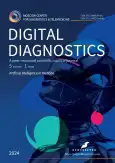Organizing follow-up care for patients with macular retinal pathologies using artificial intelligence systems
- Authors: Chuprov A.D.1, Bolodurina I.P.2,3, Lositskiy A.O.1, Zhigalov A.Y.2
-
Affiliations:
- The S. Fyodorov Eye Microsurgery Federal State Institution
- Orenburg State University
- Orenburg State Medical University
- Issue: Vol 5, No 1 (2024)
- Pages: 75-84
- Section: Original Study Articles
- URL: https://journals.rcsi.science/DD/article/view/262974
- DOI: https://doi.org/10.17816/DD623956
- ID: 262974
Cite item
Abstract
BACKGROUND: The Order of the Ministry of Health of Russia “On Approval of the Procedure for the Provision of Medical Care to the Adult Population for Diseases of the Eye, Appendages, and Orbit” provides for equipping consultation and diagnostic departments of outpatient clinics with optical coherence tomographs. However, case follow-up of patients with retinal pathology is most commonly performed in ophthalmology centers, limiting treatment accessibility for patients with primary (newly diagnosed) pathologies requiring immediate treatment initiation. The available approach requires modification and intensification, including the use of artificial intelligence technologies.
AIM: To develop methodological foundations for organizing follow-up care for patients with posterior segment eye diseases using an artificial intelligence-based clinical decision support system.
MATERIALS AND METHODS: The existing regulatory framework was analyzed based on the Constitution of the Russian Federation, federal laws, by-law framework, and judicial practice. A structured medical document describing an optical coherence tomography image was created using an expert method: a survey of 100 ophthalmologists with an appropriate education level, including additional professional training, engaged specialized medical care for patients with posterior segment eye diseases was performed.
RESULTS: Using an expert method, 123 binary features were selected to describe the structure of the macular area of the retina under normal and pathological conditions, with 26 features identified as predictors of a worsening clinical course of the disease.
CONCLUSION: The proposed classifier enabled the creation and training of a medical decision support system based on 60,000 medical images, which, as an information service, without making a diagnosis, can change the case follow-up process. Routing of patients is a primary service of the proposed system. If the clinical picture shows signs of deterioration, a referral to an ophthalmology center is considered to assess the course of the disease and provide specialized services, including high-tech medical care.
Full Text
##article.viewOnOriginalSite##About the authors
Aleksandr D. Chuprov
The S. Fyodorov Eye Microsurgery Federal State Institution
Email: nauka@ofmntk.ru
ORCID iD: 0000-0001-7011-4220
MD, Dr. Sci. (Medicine), Professor
Russian Federation, OrenburgIrina P. Bolodurina
Orenburg State University; Orenburg State Medical University
Email: prmat@mail.osu.ru
ORCID iD: 0000-0003-0096-2587
SPIN-code: 4848-0669
Dr. Sci. (Engineering), Professor
Russian Federation, Orenburg; OrenburgAleksandr O. Lositskiy
The S. Fyodorov Eye Microsurgery Federal State Institution
Email: eyedoct@yandex.ru
ORCID iD: 0000-0002-8716-6438
SPIN-code: 2044-3410
MD, Cand. Sci. (Medicine)
Russian Federation, OrenburgArtur Yu. Zhigalov
Orenburg State University
Author for correspondence.
Email: prmat@mail.osu.ru
ORCID iD: 0000-0003-3208-1629
SPIN-code: 4692-9037
Russian Federation, Orenburg
References
- Diabetes mellitus: diabetic retinopathy, diabetic macular edema. Clinical guidelines. ID 115. Approved by the Scientific and Practical Council of the Ministry of Health of the Russian Federation. 2023. Available from: https://cr.minzdrav.gov.ru/recomend/115_2 (In Russ).
- Age-related macular degeneration. Clinical guidelines. ID 114. Approved by the Scientific and Practical Council of the Ministry of Health of the Russian Federation. 2021. Available from: https://cr.minzdrav.gov.ru/recomend/114_2 (In Russ).
- Health Tech Digital [Internet]. c2018-2024. Digital Therapeutics and Wellness App Users to Reach 1.4 Billion Globally by 2025, as Pandemic Accelerates Regulatory Acceptance. Available from: https://www.healthtechdigital.com/digital-therapeutics-and-wellness-app-users-to-reach-1-4-billion-globally-by-2025-as-pandemic-accelerates-regulatory-acceptance/ Cited 2023 Nov 22.
- Pugachev PS, Gusev AV, Kobyakova OS, et al. Global trends in the digital transformation of the healthcare industry. National Health Care (Russia). 2021;2(2):5–12. EDN: JADWXN doi: 10.47093/2713-069X.2021.2.2.5-12
- STADA Health Report 2020. Available from: https://www.stada.com/media/5774/stada_healthreport2020_en.pdf Cited 2023 Nov 22.
- Medvedeva EI, Aleksandrova OA, Kroshilin SV. Telemedicine in modern conditions: the attitude of society and the vector of development. Economic And Social Changes: Facts, Trends, Forecast, 2022;15(3):200–222. doi: 10.15838/esc.2022.3.81.11
- Lumbroso B, Rispoli M. Retinal OCT. Method of analysis and interpretation. Neroev VV, Zaitseva OV, editors. Moscow: Aprel’; 2012. (In Russ).
- Avetisov S, Kats M. Using optical coherent tomography in diagnosis of retinal diseases. (review of literature). Universum: meditsina i farmakologiya. 2017;(4(38)):15–26. EDN: YJAYXT
Supplementary files









